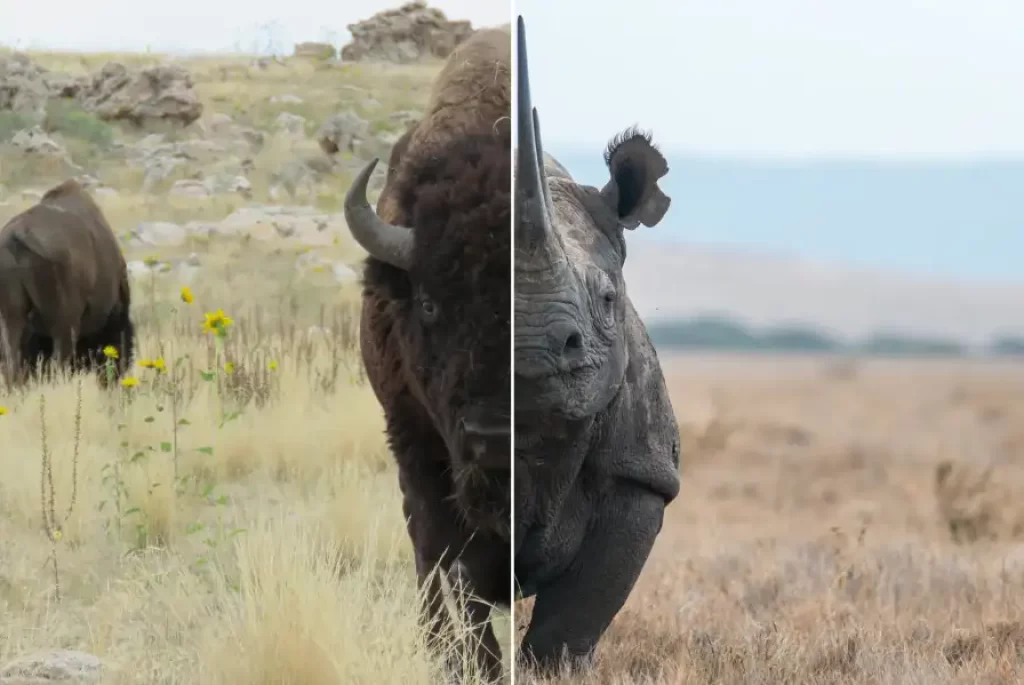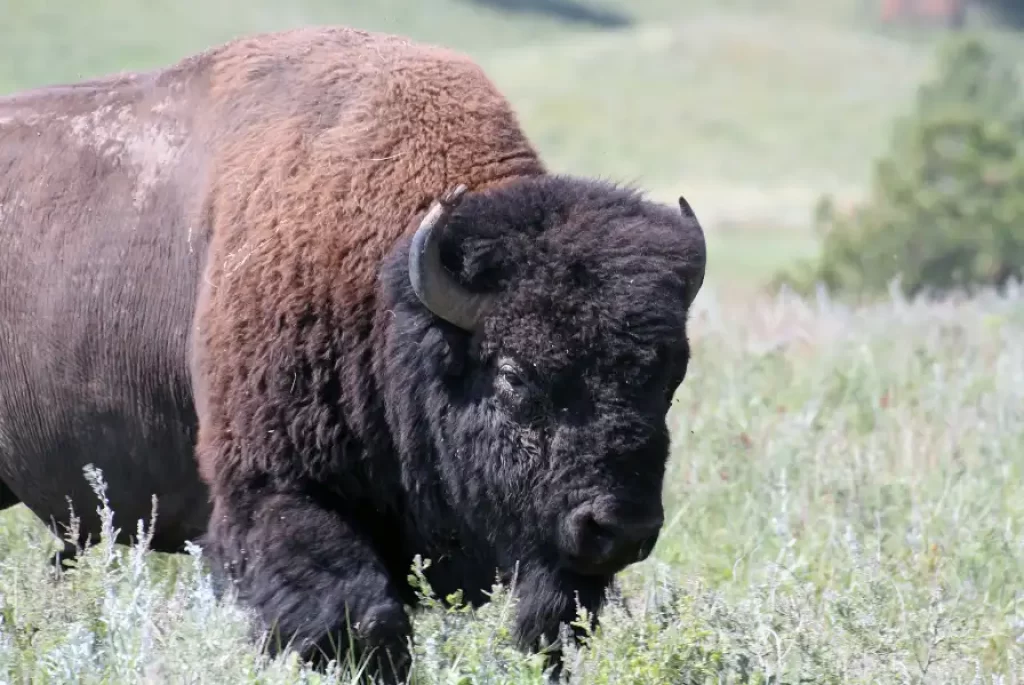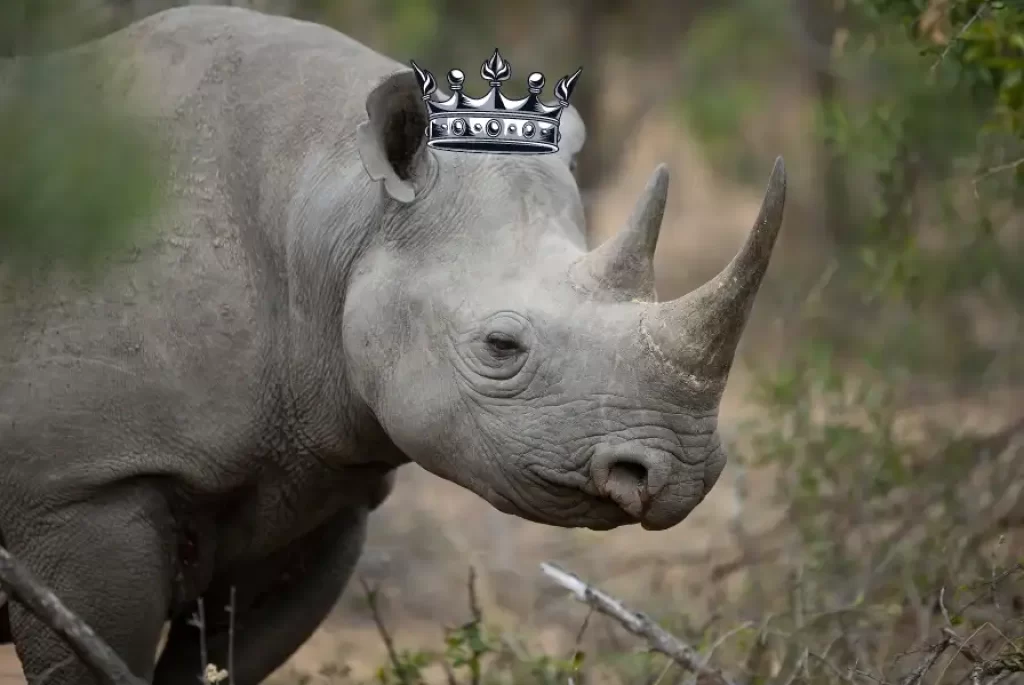Bison vs Rhino: Can a bison defeat a rhino?
In this article, we will explore the question of whether a bison can defeat a rhino in a hypothetical fight. This topic is interesting because both animals are known for their physical prowess and have evolved unique adaptations to defend themselves in their respective environments.
By comparing the physical characteristics and behaviors of bison and rhinos, we can gain a better understanding of how a fight between them might play out.
Bison are large, herbivorous mammals found in North America. They have a muscular body, a large head, and a shaggy coat of brown fur. Rhinos, on the other hand, are massive herbivorous mammals found in Africa and Asia.
They have a distinctive armored body, a single horn on their nose, and thick skin. Both animals are well-adapted to their respective habitats and have unique ways of defending themselves against predators.
| Traits | Bison | Rhino |
|---|---|---|
| Size | Medium-large (1320-1980 lb / 600-900 kg) | Large (4400-5500 lb / 2000-2500 kg) |
| Skin | Tough and durable, but less thick compared to rhinos | Thick and difficult to penetrate, with a unique dermal armor made of collagen fibers |
| Horn | No sharp horn, but males may have curved and thickened horns | Sharp horn that can grow up to 5 feet, made of keratin (the same material as human nails) |
| Aggression | Known for their aggressive behavior when threatened, and may charge at opponents | Can be extremely aggressive when threatened, and may attack without warning |
| Running speed | Slower compared to rhinos, with a top speed of around 30 miles per hour | Can run up to 30 miles per hour, making them one of the fastest land animals |
| Senses | Have a good sense of hearing and smell, which helps them detect potential dangers and avoid them | Have a keen sense of smell and hearing, and their eyesight is also good enough to detect predators |
| Threats | Poaching for their meat and hides, habitat loss, and competition with domestic livestock | Poaching for their horn (which is highly valued in traditional medicine), habitat loss, and competition with humans and domestic livestock |
Physical Characteristics and Attributes of Bison and Rhino

| Animal | Habitat | Diet | Average Weight (kg) |
|---|---|---|---|
| Bison | North America | Herbivore | 600-900 |
| Rhino | Africa and Asia | Herbivore | 1000-2000 |
Bison and rhinos are both large, herbivorous mammals that share some physical characteristics but have several distinct differences.
Bison:
- Bison are typically large, with males weighing up to 2,000 pounds (900 kg) and females weighing up to 1,000 pounds (450 kg).
- They have a shaggy brown coat with a mane of longer hair around their neck and shoulders.
- Their head is large and triangular with two curved horns, which can grow up to two feet (60 cm) long in males and are shorter and less curved in females.
- Bison have a hump on their back, which is a muscle mass that helps support their massive head and neck.
- They have a thick, muscular body with short legs, and their hooves are divided into two parts, which allow them to move easily through snow and other rough terrain.
- Bison are primarily found in North America, where they once roamed in large herds across the grasslands and prairies.
Rhinos:
- Rhinos are also large animals, with males weighing up to 5,000 pounds (2,300 kg) and females weighing up to 3,500 pounds (1,600 kg).
- They have thick, armored skin that is gray or brown in color.
- Their head is also large and triangular with a single, straight horn that can grow up to five feet (1.5 m) long in some species.
- Rhinos have a barrel-shaped body with short legs, and their feet have three toes with a thick pad of skin that helps them to walk quietly.
- Rhinos are primarily found in Africa and Asia, where they inhabit grasslands and forests.
In terms of their attributes, both bison and rhinos are strong and powerful animals, capable of charging and defending themselves when threatened. However, rhinos are known for their notoriously aggressive behavior, while bison are generally more docile.
Additionally, rhinos are facing a significant threat due to poaching for their horns, which are believed to have medicinal properties in some cultures, while bison have made a comeback from near-extinction in the 19th century and are now considered a conservation success story.
Natural Habitat and Behavioral Differences

Bison are primarily found in North America, specifically in grasslands and prairies. They are herbivores and graze on grasses, sedges, and other plants. Bison are social animals and typically live in large herds.
When threatened by predators, such as wolves or bears, they will gather together and use their sharp horns and powerful charges to defend themselves.
Rhinos, on the other hand, are found in Africa and Asia in a variety of habitats, including savannas, forests, and swamps. They are herbivores and feed on a range of vegetation, including leaves, branches, and fruits.
Rhinos are solitary animals and are highly territorial. When threatened by predators, such as lions or hyenas, they will use their sharp horn and strong body to defend themselves.
Behaviorally, bison and rhinos have some notable differences. Bison are highly social and will often form large herds, sometimes consisting of hundreds or even thousands of individuals.
They communicate with each other through a variety of vocalizations, such as grunts and bellows, and will defend their young aggressively against predators.
Rhinos, on the other hand, are solitary animals and typically only interact with each other during mating season. They are highly territorial and will defend their territory fiercely against intruders.
In terms of their defense mechanisms, bison rely on their size, strength, and sharp horns to fend off predators. They will often charge at predators when threatened, using their massive bodies and sharp horns to injure or intimidate them.
Rhinos, on the other hand, use their thick, armored skin and sharp horn to defend themselves against predators. They are also incredibly fast and can outrun many predators. Could a bison defeat a rhino?
You might also like: Here are some extra transformations about the American Bison
Comparing Bison and Rhino in a Hypothetical Fight
A hypothetical fight between a bison and a rhino would be a fierce battle, with both animals having unique physical attributes and defensive strategies.
In such a scenario, the outcome of the fight would depend on several factors, such as the size and strength of each animal, their respective fighting tactics, and the environment in which the fight takes place.
In terms of size, rhinos are larger than bison and have thick, armored skin that protects them from potential attacks.
The rhino’s horn is also a formidable weapon that could be used to inflict serious injury to the bison. However, the bison’s sharp horns and powerful charge could be enough to knock the rhino off balance and weaken its defenses.
Can a Bison defeat a Rhino?
It is highly unlikely that a bison could defeat a rhino in a fight. Rhinos are much larger and more powerful than bison, with thick skin and a powerful horn that they can use to defend themselves.
Rhinos are also known to be highly aggressive when threatened, making them formidable opponents in any confrontation.
Bison, on the other hand, are known for their speed and agility, but their size and strength are no match for a rhino. In the wild, bison and rhinos occupy different habitats and do not typically interact with each other, so a fight between them is highly unlikely to occur.
You might also like: Buffalo vs Rhino: Who Would Win in a Battle?
The winner

Although bison and rhinos are unlikely to encounter each other in the wild, some people may wonder who would emerge victorious in a hypothetical fight between the two. The rhino is the more formidable opponent due to its larger size, thicker skin, and powerful horn.
In addition, rhinos are known to be highly aggressive when threatened and will not hesitate to use their horn to defend themselves against predators, making them a formidable foe in any confrontation.
While bison are strong and powerful animals in their own right, the rhino’s size and weaponry give it the advantage in this hypothetical matchup.






